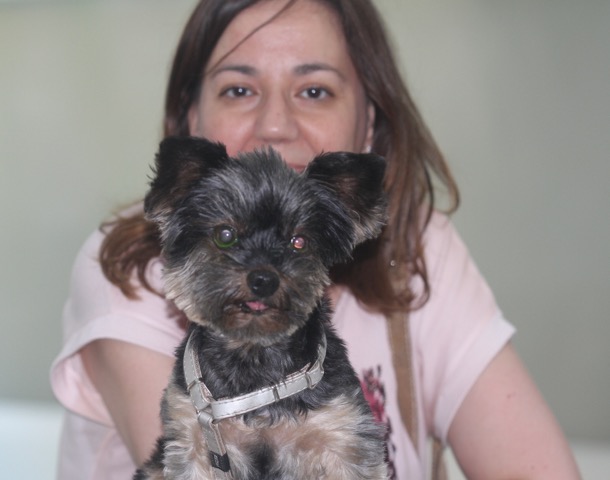El equipo de IVO presentó en el ECVO un poster con el caso clínico de Fox, un Yorkshire de 10 años operado de melanoma de conjuntiva.
Este tipo de tumores no son frecuentes en medicina veterinaria, y un 81% de ellos son malignos. En el caso de Fox, la biopsia confirmó que el tumor era maligno. Se le practicó la cirugía para extraer el tumor y tratamiento con quimioterapia.
A los 6 meses se pudo comprobar que el tumor no había reaparecido.

A los 6 meses se pudo comprobar que el tumor de Fox no había reaparecido. Foto: IVO
Incluimos a continuación el texto íntegro del póster, junto con la imagen para descargar.
U. Fernandez, F. Simo & MD Torres
Instituto Veterinario Oftalmológico, Barcelona, Spain
To describe a case of recurrent conjunctival amelanotic melanoma in a canine patient.
9-year-old male Yorkshire terrier presented with a depigmented proliferative mass (Fig. 1a,b) on the ventral palpebral conjunctiva of the left eye. Excisional biopsy without adjutant local therapy was performed. A definitive diagnosis of amelanotic melanoma, was confirmed by immunohistochemistry stains due to the high expression of Melan A (Fig. 2a,b). Relapse of the tumor was observed 1 month later and excisional surgery with adjuvant therapy was performed, with major surgical margins and double freeze-thaw cryotherapy was performed, to prevent possible future relapses. On initial post surgery treatment, topical and oral antibiotics and a mitomycin C 0,04% (MMC) collyrium were used, TID in two-week cycles and one-week rest period. The only adverse effect associated was mild blepharitis. After six month, tumor recurrence had not been observed. (Fig. 3)
Conclusions
In the present case, surgical excision followed by cryotherapy and topical treatment with MMC helped preventing the tumor recurrence. In the authors’ knowledge this is the first reported case of canine amelanotic conjunctival melanoma and its surgical treatment with topical chemotherapy.
Melanocytic tumors are not common in veterinary medicine and 81% of them are malignant. The Rottweiler and Cocker spaniel breeds are predisposed. (1,2). They have a great potential of local relapse in spite to the aggressive surgeries performed, although systemic metastasis is usually low, being the palpebral conjunctiva the location with greater potential for recurrence and also metastasis. (1,3) The definitive diagnosis is made by histopathology and, in case of amelanotic melanomas, with the confirmation by immunohistochemistry, using markers such as Melan A (as in our case) or the HMB 45. (3,4) In human medicine, different protocols for the surgical excision of conjunctival melanomas and adjuvant therapies before or after surgery are described.(5-7) MMC is used because it affects all cellular phases inhibiting neoplastic and fibrovascular tissue growth after surgery (8-10) ; in veterinary medicine is used to reduce corneal and conjunctival fibrosis on glaucoma surgery, as well as chemotherapeutic adjuvant in keratectomy for squamous cell carcinomas. (6,9) Intraoperative cryotherapy is used to induce necrosis of the margins of tumor cells during the part of thawing causing the efflux of the intracellular contents. (7)
BIBLIOGRAPHY
1 .- Dubielzig, R.R .; Ketring, K.L .; Mclellan, G.J .; Albert, D.M. Veterinary Ocular Pathology: A Comparative Review; W.B. Saunders: Philadelphia, PA, USA, 2010; p. 472
2.-Adriana Tomoko Nishiya , Cristina Oliveira Massoco, Claudia Ronca Felizzola, Eduardo Perlmann , Karen Batschinski , Marcello Vannucci Tedardi , Jéssica Soares Garcia , Priscila Pedra Mendonça, Tarso Felipe Teixeira and Maria Lucia Zaidan Dagli. Comparative Aspects of Canine Melanoma.Veterinary Science 2016. 3, 7, 1-22.
3. – Reilly, C.R, Dubielzig, R.R, Newman, S.J, Bergman, P.J. Features of canine conjunctival melanocytic tumors. Abstracts: 36th Annual Meeting of the American College of Veterinary Ophthalmologists, Nashville, TN, USA, October 12–15, 2005.
4.-Damir Kovacevic, Koraljka Lukanovic Primc, Vedran Markusic, M rijana Bilen Babic and Darko Ledic. Amelanotic malignant melanoma, case report 2011.Collegium antropologicum 2011. 35, 2,2, 295 – 297.
5.- Fariba Ghassemi, MD; Hadi Ghadimi, MD; Mojgan Nikdel, MD. Resolution of Primary Acquired Melanosis with Atypia after Treatment with Topical Mitomycin C and Interferon Alfa-2b. Journal of Ophthalmic Vision Research 2015. 10 , 84-86.
6.- Jessica C. Nevile, Simon D. Hurn, Andrew G. Turner and Christina McCowan. Treatment of canine corneal squamous carcinoma with lamellar keratectomy and strontium plesiotherapy 90: 3 cases. Veterinary Ophthalmology 2015. 18, 3, 254–260.
7.-James R Wong, Afshan A Nanji, Anat Galor and Carol L Karp. Management of conjunctival malignant melanoma: a review and update. Expert Review of Ophthalmology 2014; 9(3), 185–204.
8.- Hakan Demirci, MD; Steven A. McCormick, MD; Paul T. Finger, MD. Topical Mitomycin Chemotherapy for Conjunctival Malignant Melanoma and Primary Acquired Melanosis With Atypia . Graefe’s Archive for Clinical and Experimental Ophthalmology 2005.11 ,1108 -1114.
9.-K, Karasawa, H. Matsuda and A.Tanaka. Superficial keratectomy and topical mitomycin C as therapy for a corneal squamous cell carcinoma in a dog. Journal of Small Animal Practice 2008. 49, 208–210.
10.- Rangan Gupta, Benjamin W. Yarnall, Elizabeth A. Giuliano, Jagat R. Kanwar, Dylan G. Buss and Rajiv R. Mohan . Mitomycin C: a promising agent for the treatment of canine corneal scarring . Veterinary Ophthalmology